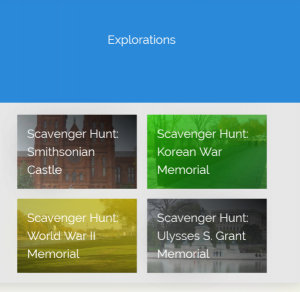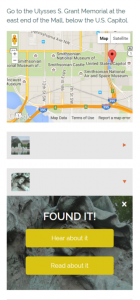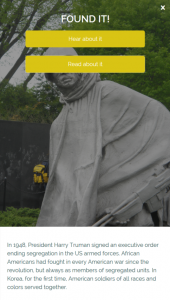Written by George Mason University History Professor Michael O’Malley who developed the structure, content, and media for four scavenger hunts.

I began from the premise that much of the pleasure and value of history lies in the appreciation of small details, and that history involves an element of detective work. We needed to identify elements of the mall which were not obvious, but relatively easy for tourists to find. We wanted the items identified to add depth to the experience of each site, and we hoped the process of searching would invite closer scrutiny and consideration.

The Grant Memorial offers one example. This powerful piece of public art hides in plain sight: everyone sees it, but few stop to look. In finding the details, the story each group tells becomes more clear. Users are asked to find the snapped harness that plunges a wagon into chaos: they find the abandoned rifle that speaks of fatigue and loss, and a sculpted letter, lying half buried nearby. Finally they locate the face of a fallen rider, modeled on the sculptor, Henry Merwin Schrady. Completing the scavenger hunt conveys the deep detail, narrative complexity, and careful choices that went into this stunning work.
A second scavenger hunt centered on the Korean War Memorial. We ask users to locate the face of an African American. They then learn about Truman’s 1948 order desegregating the armed forces. Discovering the field radio in another statue’s hand, prompts a discussion of the difficulties of communication in an age before cell phones and satellites.

When they find the stone listing the number of Americans killed in the war, they are gently reminded of the dramatically high casualties in places other than the US.
I began by scouting memorial sites by walking the Mall with a digital camera, identifying and photographing likely “finds,” and in some cases returned on a day with better light. The photos, including multiple overviews and four closeups of the items to be found, were then each given a short 3-5 sentence description, aimed at situating the smaller item in relation to the larger site.
Photos were chosen because they were easy things to overlook, but when noticed, enriched the experience of the site. And ornamental detail of the Castle building, for example, becomes an occasion for discussing the local quarry where slaves labored.
For each scavenger hunt, I composed some simple theme music, roughly appropriate to the period being described. For example, the WWII memorial theme is a short loop of big-band swing. The songs were composed and played via Apple’s LogicPro software, which includes a large library of sampled instruments and drum beats, all copyright free, which can used easily in many contexts. I used a mix of real instruments and pre-recorded samples. For the WWII gold star image, a more somber and elegiac piece of music was substituted for the big band style theme. Then, I recorded a voiceover to go with each “found” item, beginning with the site’s theme and then including an audio narration of the text description.
The four scavenger hunts can get users thinking about a variety of historical subjects: technology, the decorative arts, military technology, the place of women in history, and the choices made in designing memorials themselves. Because of the varied music, each has a different “feel.” Users will get a sense that history tells many stories and opens many lines of inquiry, and that the Mall rewards visitors with an eye for detail as well as for grand scale.